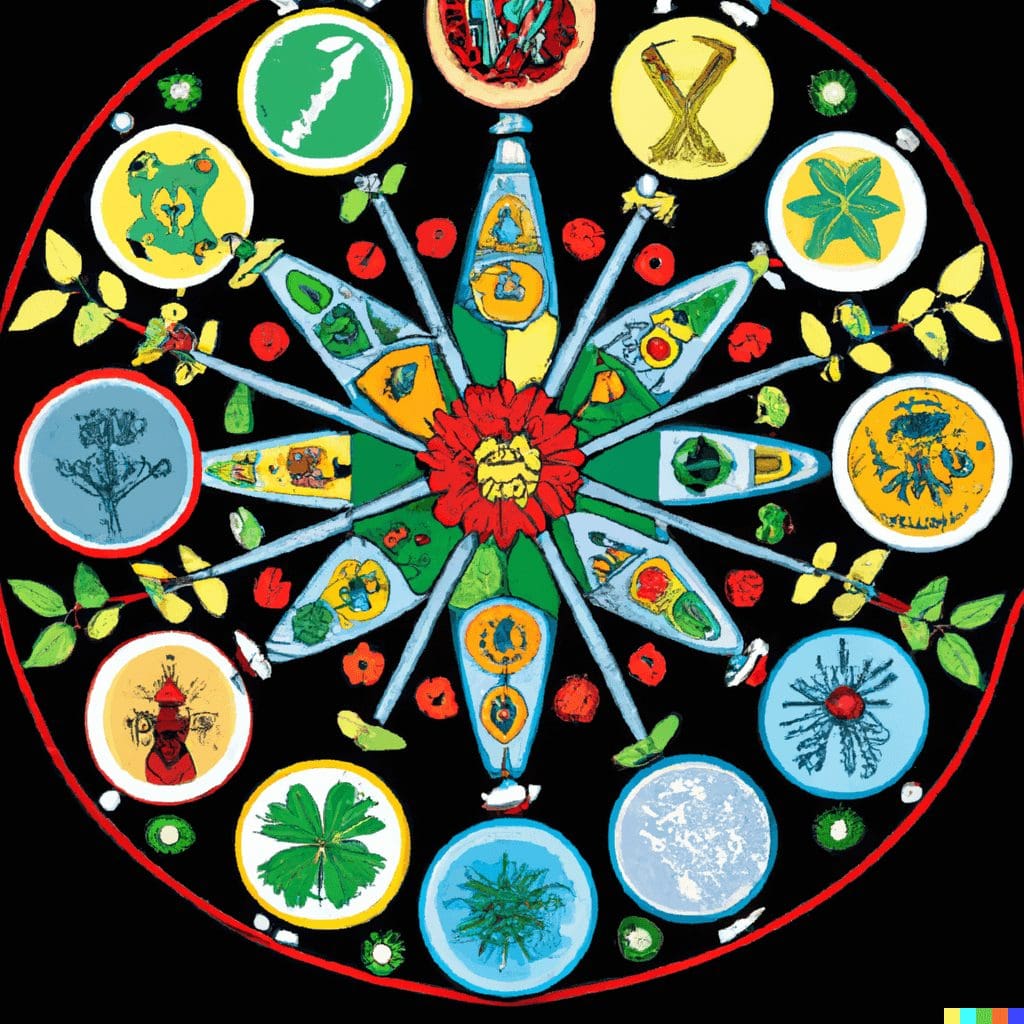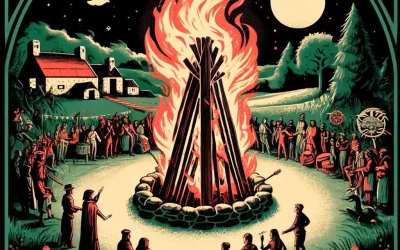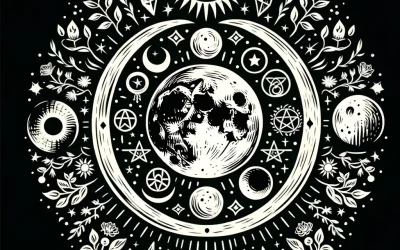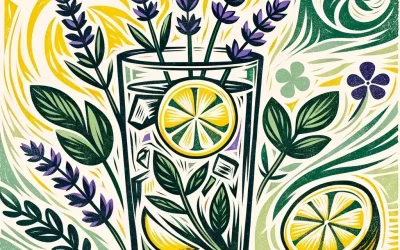LEARN | PAGANISM
PAGANISM 101
Embracing Diverse Traditions and the Sacred Cycles of Life
Updated: March 1, 2024

What is Paganism?
Paganism, in its broadest sense, encompasses a diverse range of earth-centered belief systems that typically honor multiple deities and revere nature. It’s like a spiritual potluck where everyone brings a different dish to the table.
The Origin of Paganism
Paganism’s roots extend far beyond the familiar landscapes of pre-Christian Europe, reaching into every corner of the world where indigenous cultures have connected with the divine through nature. From the ancient ceremonies at Stonehenge to the sacred groves of the Celts, from the intricate Norse runes to the spiritual practices of the Americas, Africa, Asia, and beyond, paganism has been a universal expression of humanity’s relationship with the earth, the cosmos, and the cycle of life and death. It is a rich selection of beliefs and rituals that celebrate the natural world and its seasons, offering diverse paths to understanding the mysteries of existence.
Pagan Lore
You can’t dip your toe into paganism without the lore splashing up to greet you. Legends, myths, and divine dramas abound, giving the Marvel Cinematic Universe a run for its money. From the love affairs of Zeus in Greek mythology to the heroic adventures of Odin in the Norse sagas, pagan lore is a rich tapestry of tales that reflect humanity’s deepest fears and desires.
What Does Being a Pagan Mean?
Being a pagan means embarking on a spiritual journey deeply rooted in reverence for nature, engagement with a variety of deities or spiritual forces, and a commitment to personal responsibility and growth. Paganism encompasses a wide spectrum of beliefs and practices, reflecting the diversity of its adherents. Each individual pagan navigates their own unique path, crafting a spiritual practice that resonates with their personal beliefs and connections to the natural and divine world.
What do Pagans Believe?
Pagan beliefs can be as varied as wildflowers in a meadow. Yet, at the heart of many pagan paths is a respect for nature, an appreciation for the divine in its many forms, and a belief in the interconnectedness of all life. It’s like an all-you-can-believe buffet, and the belief that each individual has the freedom to craft their spiritual practice is a key ingredient.
What do Pagans Worship?
Some pagans honor a pantheon of deities, each with their distinct attributes and lore. From the Celtic Morrigan to the Greek Dionysus, the deities are as numerous as the stars. But worship in paganism is not limited to deity reverence. Many pagans also revere nature itself, seeing the sacred in the sun, moon, rivers, mountains, and animals.
Common Pagan Traditions: A Spiritual Smorgasbord
Gather around, spiritual explorers, as we embark on a whirlwind tour of some shared traditions in the wildly diverse world of paganism. It’s like a spiritual buffet, and we’re about to feast our eyes on some of the most appetizing offerings.
The Reverence of Nature
In all its various flavors, Paganism has a deep-rooted love affair with Mother Nature. Pagans view the natural world not as a stage for human activity but as a divine entity to be revered and protected. It’s akin to viewing a magnificent painting not as a mere backdrop but as a masterpiece itself.
Polytheism
Most pagan paths are comfortably polytheistic, which means they honor a myriad of deities. Whether they are praying to the Norse Thor for strength or the Celtic Brigid for inspiration, pagans see divinity as multifaceted, like a celestial diamond reflecting infinite divine expressions.
The Wheel of the Year
Regardless of whether you’re an urban druid or a traditional Wiccan, the Wheel of the Year keeps on turning. With eight Sabbats marking the ebb and flow of seasons, pagans universally celebrate the cycle of life, death, and rebirth that the Earth undergoes yearly. It’s like the Earth’s very own version of a birthday party, celebrated multiple times a year!
Magic and Rituals
If paganism were a play, magic, and rituals would be its dynamic protagonists. Rituals are often performed during the Sabbats or to mark life transitions, while magic is seen as a means of engaging with the subtle energies of the universe. These practices, from casting circles and invoking deities to crafting charms and divination, add an enchanting sparkle to the pagan path.
The Different Pagan Holidays: Major and Minor Sabbats
Step right up and behold the magnificent Wheel of the Year, a thrilling merry-go-round of eight diverse pagan holidays known as Sabbats. They’re split into Major and Minor Sabbats, and they all offer their own unique spiritual thrills. In the context of paganism, the terms “major” and “minor” Sabbats refer to the distinction between the festivals that mark the solstices, equinoxes, and the midpoints between them.
Greater Sabbats
The greater Sabbats, also known as the cross-quarter days, are Samhain, Imbolc, Beltane, and Lammas (also known as Lughnasadh). These Sabbats fall approximately midway between the solstices and equinoxes and are often associated with agricultural milestones and Celtic traditions.
Imbolc
Imbolc (February 2): Celebrates the beginning of spring and is associated with the Celtic goddess Brigid.
Beltane
Beltane (May 1): Marks the start of summer and is a celebration of fertility.
Lammas
Lammas/Lughnasadh (August 1): The first harvest festival, celebrating the bounty of the land.
Samhain
Samhain (October 31): The pagan new year marking the end of the harvest season and the beginning of winter.
Lesser Sabbats
The lesser Sabbats, also known as the quarter days, corresponds to the solstices and equinoxes. These are Yule, Ostara, Litha, and Mabon.
Ostara
Ostara (circa March 21): The spring equinox, when day and night are equal in length, marking the beginning of spring.
Litha
Litha (circa June 21): The summer solstice, the longest day and shortest night of the year.
Mabon
Mabon (circa September 21): The autumn equinox, another day of equal light and darkness, marking the beginning of autumn.
Yule
Yule (circa December 21): The winter solstice, marking the shortest day and longest night of the year.
Pagan Holidays and There Modern Counterparts
While many pagan holidays have been lost to history, some continue to be celebrated today, often with modern adaptations. Below are three examples of ancient pagan holidays and their mainstream counterparts:
Samhain and Halloween
Samhain, an ancient Celtic festival, marked the end of the harvest season and the beginning of winter. It was believed that the veil between the living and the dead was thinnest at this time, allowing spirits to roam the earth. Today, we celebrate Halloween, which incorporates elements of Samhain, such as costumes, to ward off evil spirits and the celebration of the supernatural.
Winter Solstice and Christmas
The Winter Solstice has long been celebrated by various pagan cultures, honoring the return of the sun and the gradual lengthening of days. The Roman festival of Saturnalia and the Norse Yule are two examples of ancient solstice celebrations. Many customs from these holidays, such as gift-giving and feasting, were incorporated into the Christian celebration of Christmas.
Ostara & Easter
Ostara, also known as Eostre, was a pagan festival celebrating the spring equinox and the renewal of life. The holiday was named after the Germanic goddess of fertility and dawn, and its symbols, such as eggs and rabbits, continue to be associated with Easter. The Christian holiday commemorates the resurrection of Jesus Christ but incorporates many elements from Ostara, such as the use of eggs in festivities.
Witches & Pagans: The Difference
Ah, the age-old confusion between witches and pagans. It’s a bit like comparing apples and fruit salads. All apples (witches) are fruits (pagan), but not all fruits are apples. Witchcraft is a practice that can be part of someone’s pagan belief system, but not all pagans are witches.
The Decline of Paganism
Paganism never really “died out.” It just went undercover for a while, like a mythical beast lurking in the depths of a forest. The spread of Christianity and its subsequent dominance largely overshadowed paganism.
Paganism: Demonized or Misunderstood?
From “witch trials” to “devil worshipping,” paganism has often been on the wrong end of the rumor mill. It’s like the spiritual equivalent of high school gossip, only with far more severe consequences. A combination of misunderstandings, fear of the unknown, and power dynamics have contributed to paganism’s undeservedly bad reputation.
The Many Branches of Paganism
Paganism is not a monolithic religion, but a sprawling tree with many branches. Wicca, Druidry, Asatru, Hellenic Polytheism, and Eclectic Paganism are just a few of these branches. Each has its own unique beliefs, practices, and rituals, yet all share a common root in reverence for nature and a multiplicity of deities.
Wicca
A modern pagan, witchcraft religion that was popularized in the mid-20th century by figures like Gerald Gardner and Doreen Valiente. Wicca often involves reverence for a goddess and god, as well as the practice of witchcraft and the celebration of eight seasonal Sabbats.
Druidry
Rooted in the ancient Celtic culture, Druidry is a spiritual path that emphasizes reverence for nature, the ancestors, and the gods and goddesses of Celtic mythology. Modern Druids often participate in rituals, ceremonies, and creative arts to honor these connections.
Asatru (Heathenry)
A revival of the pre-Christian religion of the Germanic and Norse people, Asatru focuses on the worship of the gods and goddesses from the Norse pantheon, such as Odin, Thor, and Freyja. It also emphasizes the importance of ancestral veneration and living according to the values of the ancient Norse, such as courage, honor, and loyalty.
Hellenism
A modern revival of the ancient Greek religion, Hellenism involves the worship of the Greek gods and goddesses, such as Zeus, Athena, and Aphrodite. Hellenic pagans may also participate in rituals, festivals, and other practices inspired by ancient Greek traditions.
Stregheria
An Italian witchcraft tradition, Stregheria is rooted in the folk magic and religious practices of pre-Christian Italy. It often involves the veneration of Italian deities and spirits, as well as the practice of witchcraft and divination.
Kemeticism
A revival of the religion of ancient Egypt, Kemeticism involves the worship of Egyptian deities, such as Ra, Isis, and Osiris. Kemetic pagans often participate in rituals, prayer, and other practices based on ancient Egyptian religious traditions.
Slavic Paganism (Rodnovery)
Eclectic Paganism
Some pagans choose to create their own unique spiritual path by drawing upon elements from various pagan traditions and other spiritual practices. Eclectic pagans may create personalized rituals, beliefs, and practices based on their individual needs and preferences.
These are just a few of the many paths within paganism. It’s essential to remember that each person’s spiritual journey is unique, and one may feel drawn to multiple paths or traditions or even create their own personalized practice.
Are There Still Pagans Today?
Paganism’s kicking alive, with modern-day believers tweaking ancient vibes to fit their city-dwelling, tech-wielding lifestyles. Urban Druids? They’re rocking tree rituals in concrete jungles, turning city parks into sacred groves. Wiccans are no less crafty, whipping up spells between WiFi and coffee sips, celebrating solstices in whatever space they can conjure.
Heathens are toasting to Odin with craft beer in hand, while Hellenic followers give Zeus his dues beside buzzing smartphones. And let’s not forget the solo flyers, mixing gods and rituals like spiritual cocktails tailored to taste.
The truth? Paganism is as spry as ever, morphing to fit in with subways, skyscrapers, and smartphones. Celebrating nature’s cycles doesn’t need rolling hills; a patch of grass between sidewalks will do. So yeah, the old ways are getting a fresh, irreverent twist—because that’s how modern magic rolls.
Sigils & Paganism
Sigils in paganism are like the emojis of magical intent. They are symbols crafted to represent a specific intention or desire. Imagine being able to write a text message to the universe, that’s what a sigil can be for a pagan.
Tips for Starting Your Pagan Journey
Embarking on a pagan journey? Here are some no-nonsense, practical tips to get you started. Think of this as your spiritual toolkit, a little less woo-woo and a lot more ‘let’s do this’.
- Read Up: Knowledge is power, especially in paganism. Grab books, browse articles, and maybe even delve into some podcasts. Mix the old with the new – from ancient myths to modern practices. I would highly suggest reading Margot Adlers book (the 2006 edition) Drawing Down the Moon.
- Connect with Nature: Paganism is big on nature vibes. Spend time outdoors, plant something, or just meditate under a tree. It’s like charging your spiritual battery.
- Explore Paths: Paganism is a buffet of spiritual paths. Dive into a bit of Wicca, get a taste of Druidry, or even create your own blend with Eclectic Paganism, where you craft a path that uniquely resonates with you. Find what truly speaks to your soul, beyond what’s trendy or popular. This journey is about personal resonance and authenticity, not just what’s in vogue on social media.
- Journal Your Journey: Keep a journal. Jot down thoughts, feelings, dreams, and experiences. It’s like having a conversation with your future enlightened self.
- Celebrate the Sabbats: This is how I started. Tune into the Wheel of the Year. Celebrate the solstices, equinoxes, and other pagan holidays. It’s like throwing a party for the earth, and you’re invited.
- Meditate and Reflect: Meditation isn’t just for monks. Spend some quiet time reflecting on your beliefs and what you seek from this path. It’s like doing a software update for your soul.
- Join a Community: Find a local or online pagan community. Share experiences, ask questions, and maybe attend a ritual or two. It’s like finding your tribe, complete with shared spiritual hashtags.
- Practice Rituals: Start simple. Light a candle, incense, or just sit and absorb the moonlight. Rituals don’t have to be elaborate – sometimes, less is more.
- Craft Your Altar: Create a personal altar. It could be elaborate or just a few meaningful items on a shelf. It’s your spiritual home base, minus the mortgage.
- Stay Open and Flexible: Your path might twist and turn. Embrace the journey with an open heart and mind. It’s less about finding the right answers and more about discovering your truths.
So, grab your metaphorical hiking boots and start trekking through the pagan wilderness. The path might be unpredictable, but hey, that’s where the adventure lies! 🌲🌟🔮
Learn About Sabbats
You’ve just stumbled upon your new favorite travel guide through the cosmic calendar, the Wheel of the Year.
Imbolc
February
Ostara
March - Spring Equinox
Beltane
May
Litha
June - Summer Solstice
Lughnasadh
August
Mabon
September - Autumn Equinox
Samhain
October
Yule
December - Winter Solstice

Embrace the Moon's Rhythm
Delve deeper into lunar lore with us. Tracking full moons, new moons, and more!
Journey Through Paganism
From sacred holidays to sigil crafting, nature magic, celestial divination, and spiritual energy harnessing.



